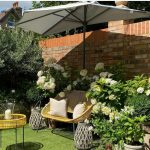Self-watering garden beds are exactly what they sound like – they are beds that water your plants for you. They usually have a water reservoir built into them that you can fill up, and then the bed will slowly release water to the roots of your plants as they need it.

Why self-watering garden beds is a good idea?
There are many reasons why self-watering garden beds are a good idea. For one, they save you time and effort because you don’t have to water your plants as often. They also help to keep your plants healthy because they provide a consistent supply of water.
How do self-watering garden beds work?
Self-watering garden beds are a great way to reduce the amount of time and effort you need to spend watering your plants. They can be used for both indoor and outdoor plants and can be customized to suit your specific gardening needs.
Self-watering garden beds work by slowly releasing water to the roots of your plants, using a wicking system. This means that your plants can stay hydrated for longer, and you won’t need to water them as often.
Benefits of self-watering garden beds
If you are someone who loves to garden, you may be thinking about investing in a self-watering garden bed. This type of garden bed can be a great investment because it offers several benefits.
There are many benefits to using a self-watering garden bed, including the fact that they require less water than traditional garden beds, and that they can help to prevent over or under-watering of plants. They also help to improve drainage in the garden bed and can be a great way to reduce weeds.
One of the benefits of self-watering garden beds is that they can help to conserve water. If you live in an area that is prone to drought, this can be a great way to keep your plants healthy and hydrated.
Another benefit of self-watering garden beds is that they can help to prevent soil erosion. When it rains, the water can run off of the soil and cause erosion. If you have a self-watering garden bed, the water will be stored in the bed and won’t be able to run off.
One final benefit of self-watering garden beds is that they can help to promote healthy plant growth. The reason for this is that the roots of the plants will be able to access the water more easily. This can lead to healthier plants that are better able to withstand pests and diseases.
How to build a self-watering garden bed
There are a few things to consider when setting up a self-watering garden bed, such as the size and type of plants you want to grow, and the amount of water they will need. You will also need to make sure that the bed has good drainage so that the roots don’t become waterlogged.
If you want to make your own, you’ll need a container (like a plastic storage bin), a drill, some PVC pipe, and a wicking material (like a cotton rope).
To make a self-watering garden bed, start by drilling holes in the bottom of your container for drainage. Then, cut a piece of PVC pipe to fit snugly inside the container. The pipe should be long enough to reach up to the top of the soil.
Next, thread your wicking material through the PVC pipe. Make sure that the material is long enough to reach all the way down to the bottom of the container.
Now, fill your container with soil and plant your plants. Water the plants until the soil is moist, then add water to the reservoir. The water will slowly wick up through the soil and to the roots of your plants, keeping them hydrated.
You’ll need to top off the reservoir every so often, but other than that, self-watering garden beds are pretty much maintenance-free!
Tips for using self-watering garden beds
If you are new to gardening or are looking for a way to make your gardening easier, self-watering garden beds may be the answer. Here are some tips for using self-watering garden beds:
- Choose the right location. Self-watering garden beds should be placed in an area that receives at least six hours of sunlight per day.
- Prepare the bed. Self-watering garden beds can be either raised beds or in-ground beds. If you are using a raised bed, make sure it is at least 18 inches deep. If you are using an in-ground bed, remove all grass and weeds from the area.
- Add the self-watering system. There are a variety of self-watering systems available. Choose one that is appropriate for the size of your garden bed.
- Plant your plants. Once you have added the self-watering system, you can plant your plants. Be sure to water them well before adding the self-watering system.
- Add mulch. Mulch will help to retain moisture in the soil and will also help to control weeds.
- Water the bed. Once you have planted your plants, water the bed thoroughly. Then, add water to the self-watering system as needed.
- Enjoy your garden! Self-watering garden beds can make gardening easier and more enjoyable. With a little bit of planning and effort, you can have a beautiful garden that is easy to care for.
Related Posts
How to take care after set up a self-watering garden beds
Caring for a self-watering garden bed is actually quite easy. You will need to top up the water reservoir every so often, but other than that, you don’t have to do much. Just let the bed do its job and water your plants for you. Also, keep in mind-
- Always make sure that the water reservoir is full before leaving your plants unattended.
- Check the soil moisture level regularly and adjust the water level accordingly.
- Avoid using chemicals or fertilizers in the water reservoir as they can clog the system.
- Be mindful of the drainage holes to prevent waterlogging.
- Inspect the system regularly for any leaks or blockages.
Is there any wrong with self-watering garden beds?
Self-watering garden beds are a type of raised garden bed that has a water reservoir built-in. They are often marketed as a low-maintenance way to grow plants, but several potential problems can occur with self-watering garden beds.
One problem is that the reservoir can become a breeding ground for mosquitoes. If the reservoir is not cleaned out regularly, it can become a stagnant pool of water that is perfect for mosquito larvae to develop into adults.
Another problem is that the plants in self-watering garden beds can become waterlogged if the reservoir is not emptied regularly. This can lead to the roots of the plants rotting and the plants themselves becoming unhealthy.
Conclusion
If you’re looking for an easy and efficient way to water your plants, self-watering garden beds are the way to go. They use a reservoir of water to keep the soil moist, so you don’t have to worry about watering your plants every day. Plus, they’re great for small spaces or areas with limited water access.
Once you have everything set up, you can sit back and relax, knowing that your plants are being watered even when you’re not around.





